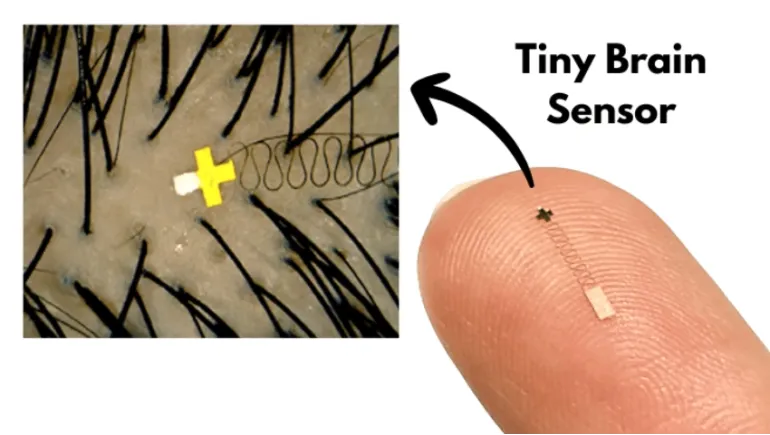
In a major leap for neuroscience and medical technology, researchers have unveiled a nanoscale brain sensor so small and thin it can fit between individual strands of human hair. This innovation marks a new frontier in how we monitor and understand brain activity, offering unprecedented levels of precision, minimal invasiveness, and real-time tracking.
As the demand for more accurate brain monitoring tools grows—spanning applications in medicine, mental health, and even human-computer interaction—this hair-thin sensor could be the key to unlocking better diagnostics, therapies, and brain-machine interfaces.
The new brain sensor is a flexible, ultra-thin device designed to detect and measure electrical activity in the brain. Unlike traditional implants or headgear-based systems, this sensor is smaller than a human hair—making it virtually unnoticeable in use. Built using advanced nanomaterials like graphene or ultra-light polymer composites, the sensor maintains high conductivity while remaining soft and pliable enough to adapt to the brain’s natural movements.
The sensor works by capturing neural signals through direct contact with the scalp or brain surface, depending on the application. It transmits data wirelessly to a receiver, enabling continuous monitoring without physical bulk or discomfort.
Traditional EEG caps and brain implants come with limitations—bulkiness, invasiveness, and low resolution. The nanoscale brain sensor’s size solves all three. By being small enough to sit between hairs, it avoids shaving the scalp or penetrating tissue. It also allows for more precise signal capture, since the device can rest closer to the source of neural activity.
This makes it especially useful for patients who require continuous monitoring, such as those with epilepsy, Parkinson’s disease, or traumatic brain injury. The ability to wear a nearly invisible sensor day and night opens new doors for long-term diagnostics and personalized treatment plans.
Patients with chronic neurological conditions could benefit from round-the-clock monitoring, helping doctors catch patterns or early warning signs. The data could guide adjustments in medication, therapy, or surgical plans.
For people dealing with anxiety, depression, or PTSD, tracking neural activity in real-time could help understand emotional triggers and mental health patterns, paving the way for biofeedback therapy.
The sensor's precision makes it a perfect fit for BCIs, which require accurate readings of brain signals to enable communication between the brain and external devices. This could help people with mobility impairments control prosthetics, computers, or wheelchairs with their thoughts.
With the sensor’s wearable design, users could track sleep quality or stress levels continuously without bulky headgear or intrusive equipment.
Researchers studying brain function can use this tool for more accurate experiments in natural settings, not just in sterile labs.
Wearable health technology has come a long way in recent years—from fitness bands to smartwatches. But brain-monitoring wearables have remained relatively underdeveloped due to the complexity of capturing neural data. This nanoscale sensor changes that.
Imagine a future where a small patch on your head—or even embedded into a hat—monitors your mental health, stress levels, focus, and sleep cycles. The integration of such sensors into everyday accessories could turn passive wearables into powerful health tools.
With new technology comes new responsibilities. Brain data is extremely personal, and any device that collects it must prioritize user privacy and security. If this technology becomes mainstream, there must be clear guidelines on data encryption, consent, and usage rights.
Open access to this kind of data without safeguards could lead to misuse—from insurance discrimination to workplace monitoring. Developers and regulators will need to work together to create standards that protect users while promoting innovation.
While the concept is revolutionary, it’s not without its challenges. Mass production, cost, and integration into consumer-grade products will require more development. Additionally, researchers need to ensure the sensor remains stable over long periods and does not degrade or lose accuracy with wear.
Despite these hurdles, early lab tests and clinical prototypes have shown promise, and several institutions are already pushing for commercial applications.












Comments
There are no comments for this Article.